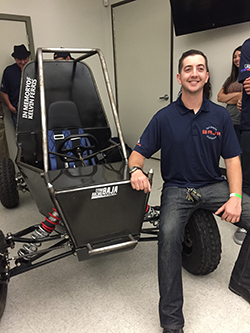By Amelia Zwecher
 Robert McFarland |
SEMA’s Career Center is an online employment resource designed to facilitate a talent pipeline for entering the automotive aftermarket. Employers are able to search résumés, set up résumé alerts and receive valuable reporting information with enhanced tools. Similarly, job seekers can post résumés, and receive alerts when potential new openings are posted.
This week, the SEMA Career Center is featuring an interview with Robert McFarland—a job seeker and an aftermarket enthusiast—regarding his career aspirations. This profile displays his extensive experience, successes and drive to work in the automotive aftermarket industry.
Below is the recent interview with McFarland:
SEMA Career Center: Are you seeking part-time or full-time work? What kind of company are you in search of?
Robert McFarland: Full-time. I’ve worked for both small and large companies. I am eager to work for a company of any size open to change, driven by logical and concise decisions. I currently live in the city of Mira Loma, California, which is within Riverside County. I prefer to not relocate.
SCC: Why do you want to work in the automotive industry?
RM: I was raised in my dad’s garage working on such restoration projects as our ’69 Chevelle Super Sport and ’67 El Camino. These projects sparked my curiosity as to what efforts were put into making these vehicles a reality. That experience is why I pursued a degree in mechanical engineering with an emphasis on manufacturing and automotive design. The passion I have for the industry is something that cannot be taught in a classroom.
SCC: What kind of opportunity are you specifically seeking?
RM: I’ve been successful in every position that I have faced, from a design engineer at an aerospace company to managing a 30-plus team in the food manufacturing industry. I am open to many opportunities; however, recently I’ve narrowed my desire to research and development to make good parts better. I believe R&D would be a good fit due to my hands-on approach and attention to details. I’d like to be just as much a part of the design process as the testing process.
SCC: How well do you write, review or maintain engineering documentation? Share an example.
RM: At my previous job as a design engineer, I was tasked with conducting and submitting failure analysis reports on returned units. The process began with documenting the returned condition of the unit followed by breakdown of the component and utilizing various test fixtures to determine failure mode of the unit. Once all data was collected, an in-depth report was written, including the finding of the analysis and how we would address those issues.
SCC: How often do you read current literature, attend meetings or conferences and talk with colleagues to stay abreast of new technology and competitive products?
RM: I am a huge fan of car shows and expos. I attend the Los Angeles and Anaheim Auto Shows as often as I can. Last year, I attended the Aerospace and Defense (AeroDef) expo in Los Angeles, as well as the Design and Manufacturing convention. Nothing beats experiencing in person the latest and greatest of what the most innovative companies should offer.
SCC: What kind of experience do you have providing technical direction to other engineers or engineering support personnel? How well was your help received?
RM: When working with fellow engineering students on the SAE Baja project, one of the biggest challenges was understanding everyone’s level of knowledge and comprehension. I held weekly and sometimes daily one-on-ones with fellow students to brainstorm and critique their designs. Most times, the feedback went well and the vehicles came together nicely.
SCC: Share an example of when you designed or analyzed automobile systems in areas such as aerodynamics, alternate fuels, ergonomics, hybrid power, brakes, transmissions, steering, calibration, safety, or diagnostics.
RM: For the SAE Baja vehicle, I took on the task of designing the suspension geometry. Research was conducted on competitor vehicles, full-scale class 1 buggies, as well as looking at the system logically for improved stability and adjustability. Manufacturing began once it was designed in Solid Works.
SCC: Describe a situation when you had to plan or organize something.
RM: As SAE president during my senior year, one of my jobs was to coordinate the attendance and delivery of our Formula and Baja teams to the Los Angeles Auto Show. Vehicle delivery and booth setup was the easy part. Challenges came about when getting nearly 100 college students to the event to represent CSUF SAE. I paired the die-hard students with the less-experienced students to encourage a learning atmosphere. I discouraged large numbers of friends going at once to minimize the risk of horseplay. Attendance for all members was necessary, and by the end of the show, we had coverage across all days, making it a success in my book.
SCC: When given an important assignment, how do you approach it?
RM: With an important assignment, I believe it is necessary to fully submerge yourself into the material. Before any major decisions are made, do as much research as possible. Gaps can easily be identified if the right questions are asked: What is the current protocol? What was done in the past? What is the goal for the future? The road of this assignment should pave itself at that point.
SCC: What do you believe are your key strengths?
RM: I’ve always been a visual learner, and through that I can pass on to others an idea often with a simple diagram. I'm also good at building relationships with people. I believe that we tend to be more productive if we feel connected to the people around us. This starts with building trust through relationships. I strive to understand things to the fullest whether it be concepts, equipment or designs.
For more information, email Amelia Zwecher and view Robert’s résumé.





